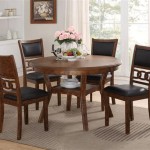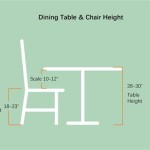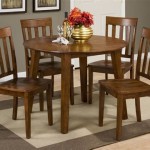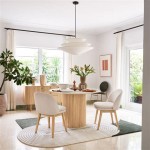Dining Table Dimensions for Four: A Comprehensive Guide
Selecting a dining table that comfortably accommodates four people requires careful consideration of dimensions. The ideal size ensures ample space for diners, dishes, and serving ware without overwhelming the room. Several factors influence the optimal dimensions, including the shape of the table, the available space in the dining area, and the desired level of formality.
The dimensions of a dining table directly impact the dining experience. Insufficient space can lead to discomfort and a feeling of being cramped, while an excessively large table can make conversation difficult and create an impersonal atmosphere. This guide provides a comprehensive overview of dining table dimensions suitable for seating four, exploring various shapes, space considerations, and ergonomic principles.
Understanding Space Requirements Per Person
The foundation of determining appropriate dining table dimensions lies in understanding the space required per diner. A general guideline is to provide at least 24 inches of width per person, allowing ample room for elbows and comfortable movement. This translates to a minimum of 48 inches along each side of a table designed for two people facing each other. Furthermore, a depth (the distance from the edge of the table to the center) of at least 12 inches per person should be allocated for placing plates, cutlery, and glassware. This ensures that diners have sufficient individual space without bumping elbows or feeling restricted.
Beyond the individual space allocation, consider the need for maneuvering room around the table. A minimum of 36 inches of clearance between the edge of the table and the surrounding walls or furniture is recommended. This allows people to comfortably pull out chairs, sit down, and move around the dining area without obstruction. Ideally, 42 to 48 inches of clearance provides even greater ease of movement, especially in high-traffic areas or when using larger chairs.
Therefore, calculating the overall footprint of the dining table requires adding the table's dimensions to the minimum clearance on all sides. Failing to account for this surrounding space can result in a cramped and uncomfortable dining environment, regardless of the table's individual size. This careful consideration is particularly crucial in smaller dining rooms or apartments where space is at a premium.
Round Table Dimensions: Intimacy and Conversation
Round dining tables are a popular choice for creating an intimate and conversational dining atmosphere. The absence of corners encourages eye contact and facilitates easy interaction among diners. For seating four people comfortably, a round table should have a diameter of at least 42 inches. This diameter provides sufficient surface area for place settings and a central serving dish without feeling overcrowded. However, for a more comfortable and spacious experience, a diameter of 48 inches or greater is recommended.
When selecting a round table, it's important to consider the base design. Pedestal bases offer more legroom than tables with traditional legs, allowing diners to sit comfortably without obstruction. A single, sturdy pedestal base is generally preferred for smaller round tables, while larger tables may benefit from a double pedestal or a four-leg design for added stability. The base should be proportioned to the table's size to ensure both aesthetic appeal and structural integrity.
The placement of a round table also requires careful consideration. It should be positioned centrally within the dining area to maximize space and create a balanced aesthetic. Avoid placing a round table in a corner, as this can disrupt the flow of the room and make it difficult for diners to access the chairs. Adequate clearance around the table, as described earlier, is essential for comfortable movement and accessibility.
Square and Rectangular Table Dimensions: Space Optimization and Formality
Square and rectangular dining tables offer a more formal and structured dining experience. They are particularly well-suited for rectangular-shaped dining rooms or areas where space optimization is a priority. For seating four people, a square table should measure at least 36 inches by 36 inches. However, a larger square table, such as 42 inches by 42 inches, provides more space for place settings and serving dishes. Square tables are best suited for smaller groups and can feel more personal than larger rectangular tables.
For a rectangular table designed for four, a minimum size of 48 inches long by 30 inches wide is recommended. This provides adequate space for two people to sit comfortably on each side. A more generous size of 60 inches long by 36 inches wide offers greater room for place settings, centerpieces, and serving dishes. Rectangular tables are versatile and can be easily extended with leaves to accommodate larger groups when necessary.
Similar to round tables, the leg placement of square and rectangular tables impacts legroom and overall comfort. Tables with legs positioned at the corners offer the most legroom, while those with aprons or decorative trim may restrict movement. When selecting a rectangular table, consider the length of the table in relation to the length of the dining room. The table should not overwhelm the space or impede traffic flow. Sufficient clearance around the table is crucial for comfortable use and accessibility.
Oval Table Dimensions: A Versatile Compromise
Oval dining tables offer a blend of the intimacy of a round table and the space efficiency of a rectangular table. The curved sides provide a softer aesthetic than a rectangular table while still allowing for efficient use of space. For seating four people comfortably, an oval table should measure at least 48 inches long by 36 inches wide. This size provides ample space for place settings and allows diners to easily converse with one another.
A larger oval table, such as 60 inches long by 42 inches wide, offers a more luxurious dining experience with increased space for serving dishes and centerpieces. The elongated shape of an oval table can be particularly well-suited for narrow dining rooms or spaces where a rectangular table would feel too angular. The curved sides also create a more visually appealing flow within the room.
When choosing an oval dining table, consider the style of the base. Tables with pedestal bases offer greater legroom and a cleaner aesthetic, while those with traditional legs provide a more classic look. The base should be sturdy and well-proportioned to the table's size to ensure stability and visual harmony. The placement of an oval table should be carefully considered to maximize space and create a balanced layout within the dining area. Adequate clearance around the table is essential for comfortable movement and accessibility.
Considering Chair Dimensions and Style
The dimensions of the dining chairs play a significant role in determining the overall comfort and functionality of the dining table setup. Chairs should be sized appropriately for the table height, allowing diners to sit comfortably with their arms resting at a natural angle. A general rule of thumb is to maintain a distance of 12 inches between the top of the chair seat and the underside of the table. This provides ample legroom and prevents diners from feeling cramped.
The width of the chairs should also be considered when determining the overall dining table dimensions. Wider chairs require more space per person, which may necessitate a larger table. It's important to measure the width of the chairs you intend to use and factor this into the calculation of required table space. Chairs with arms typically require more space than those without arms. The style of the chairs should complement the design of the table and the overall aesthetic of the dining room.
Upholstered chairs offer greater comfort than wooden or metal chairs, but they may also require more space. When selecting chairs, consider the material, construction, and durability to ensure they will withstand regular use. The weight capacity of the chairs is also an important factor, especially for accommodating guests of varying sizes. Investing in high-quality dining chairs is essential for creating a comfortable and enjoyable dining experience.
Material and Construction Considerations
The choice of material and construction significantly impacts the durability, aesthetics, and maintenance requirements of a dining table. Solid wood tables are known for their strength, beauty, and longevity. They are available in a variety of wood species, each with its own unique grain pattern and color. Solid wood tables can be more expensive than those made from other materials but offer a timeless and enduring quality.
Veneer tables consist of a thin layer of wood adhered to a core material, such as plywood or MDF. Veneer tables are often more affordable than solid wood tables and can offer a similar aesthetic appeal. However, veneer tables are more susceptible to damage and may not be as durable as solid wood tables. It's important to choose a high-quality veneer table with a sturdy core material to ensure longevity.
Metal tables offer a modern and industrial aesthetic. They are typically made from steel or aluminum and are known for their strength and durability. Metal tables are often coated with a powder-coated finish to protect against rust and scratches. Glass-topped tables offer a sleek and contemporary look. The glass should be tempered for safety and durability. The base of a glass-topped table can be made from wood, metal, or other materials. The construction of the table should be solid and sturdy to ensure stability and prevent wobbling. Regular cleaning is essential to maintain the appearance of a glass-topped table.

Tables What Size Do You Need Dining Table Sizes Restaurant Dimensions

Image Result For Restaurant Booth Seating Chart Dining Table Sizes Dimensions 4 Seater

Diner 4 Seater Dining Table Set With Upholstered Chairs Urban Ladder

Nilkamal Bella 4 Seater Dining Set Antique Cherry Furniture

Dining Table Set With 4 Chairs 5 Piece Kitchen Sets Pu Leather Faux Marble Pattern Rectangle Room For Living Restaurant Small Space Cl625 Wal Com

4 Steps For Ing A Dining Table Guide Sizes Home Decor Shelves Rustic

Dining Table Dimensions Measurements

The Dining Room Table Size Guide Ideal Sizes For 4 6 And 8 Seater Tables

4 Steps For Ing A Dining Table Guide

Standard Dining Table Dimensions And Sizes Designcafe








